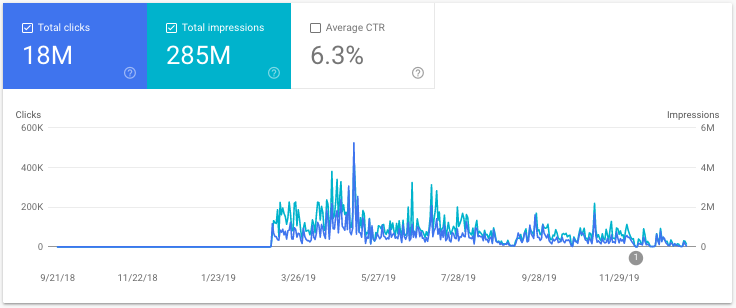Google Discover is not a new feature, but it does mark the start of a new era in SEO – that of searchless search.
First introduced in 2018, Discover (previously known as Feed) became a prominent feature on the Google Chrome mobile application and as a feature in its own right on Android devices.
The Discover feed can also appear within organic search results as a special content results block titled “Interesting finds.”
However, this is much rarer than other rich results.
It is essentially an information feed containing:
- News.
- Articles.
- Video.
- Advertisements.
- Special Google rich results such as live sports scores.
It’s akin to a social media feed and is heavily personalized around things you search for (through traditional search) and YouTube videos you watch – all mixed in with Google’s AI to surface content new to the user that Google believes is relevant and interesting.
This is a very similar mechanic to how Facebook surfaces content in a non-chronological news feed.
This also represents a new challenge for SEOs.
Previously with most forms of SEM, there is an origin – typically a keyword (or subset of keywords).
You then reverse engineer it, create content, and tailor user experience to satisfy the intent behind said keyword.
With Discover, there is no origin.
 Getting your Google Discover strategy right can yield great traffic returns.
Getting your Google Discover strategy right can yield great traffic returns.After trial and error on websites from varying sectors (fintech to publishing), there is as much we can say correlates with good Google Discover performance that doesn’t, as well as a large number of unknowns.
Below are some of the optimizations we’ve made that have seen strong correlations with improved performance.
Technical SEO for Discover
When it comes to the technical correlations and performing well in Google Discover, there’s nothing new or groundbreaking.
Rather, there is re-emphasis on areas that are sometimes taken for granted or overlooked.
Mobile Friendliness
As Google Discover is only available on smartphones and tablets, it’s important that your content is mobile accessible.
Given Google’s emphasis on mobile search for a number of years, it is still surprising to see the number of websites operating without a mobile (responsive) design or a separate mobile m-dot website.
To be in the game and stand a chance of gaining visibility within Google Discover, you need to have a good mobile experience as you do on desktop. This means making sure that:
- Your mobile experience isn’t cluttered with intrusive advertisements or pop-ups.
- Any images or visuals you include in the article are accessible and “readable”, if not, make sure when a user clicks on the image it expands and can be zoomed in on.
Your content being accessible and usable on mobile devices is just one part of the overall mobile-friendliness equation, the other key part being your site speed.
There is definitely a correlation between content that loads fast and appearance within the Google Discover feed, and also a correlation with news and magazine websites making use of AMP.
Image Optimizations
As Brodie Clark has attested to in his case study around images and their impact on Google Discover, images play a pivotal role in getting traffic from Discover and having good imagery also correlates with appearing in the feed.
Experience also suggests that content performs better (and has a higher chance of appearing within the Discover feed) when you create or use unique imagery and tie it in with the content.
It’s also important to follow wider image SEO best practices and make sure that your:
- Image file size has been as losslessly compressed as it can be (not just relying on your CDN to improve your site speed).
- Have a descriptive file name appropriate for the image.
- Appropriate alt text.
- A descriptive caption.
Content Strategy: Mixed Content Mediums, Old vs. New
Aside from featuring articles and other Google-owned content features (such as live sports scores and information), YouTube also features heavily with Google Discover.
For your content strategy, this means mixing types in terms of both medium and approach.
As users search on Google and interact with Discover, it learns a lot about you and your interests and tries to serve content that it doesn’t believe you’ve engaged with previously.
The learning can take a while.
For example, I search for a lot of sports teams to find results and rosters out of general interest.
Through Discover, Google has interpreted this as me being interested in those teams.
To try and serve me useful content, it will send me live score and schedule notifications for those teams for a couple of weeks after.
To succeed in your Google Discover strategy, your content also needs to be a mix of:
- Evergreen pieces (updated to reflect accurate information).
- Pieces following the latest industry trends.
- News around relevant topics and creating informative opinion pieces around them.
It’s also worth noting that paywall-gated content does appear within the Discover feed.
Time Sensitivity & Real-Time Content
One important thing to note is that Discover does yield to real-time events and time sensitivity.
This is important to factor into your strategy as users are likely to have multiple hobbies and interests.
The overlap between their interests and your content will only be a small part of their overall interest spectrum.
This means understanding your audience – and what their wider interests may be – is important.
Feed this into your strategy.
Setting Client Expectations
If you’re looking to gain Google Discover coverage, it’s important that you set client expectations.
Most probably, it won’t transpire like almost any other form of marketing.
As you can see from the graphs shared at the start of this post, impressions and clicks are erratic peaks and troughs and not a steady growth curve that you’d expect (or desire) from traditional SEO, paid, or even social media.
From my analysis, I found that the average lifespan of a post in the Discover feed was between 2 to 3 days. This also matches Brodie Clark’s findings in his Google Discover image study.
More Resources:
- Google Discover: An Image Could Be Worth 1,000 Clicks [Case Study]
- Google Search Console Adds Report for Site Performance in Discover Feed
- A New Era of Google Search: What It Means for SEO
Image Credits
Screenshot taken by author, March 2020





